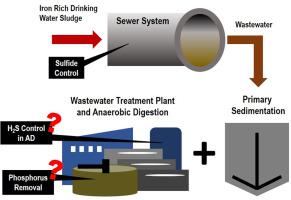Journal of Hazardous Materials ( IF 13.6 ) Pub Date : 2020-09-22 , DOI: 10.1016/j.jhazmat.2020.124051 Mario Rebosura , Sirajus Salehin , Ilje Pikaar , Jürg Keller , Keshab Sharma , Zhiguo Yuan

|
The impact of primary sedimentation on the multiple use of iron in an urban wastewater system was investigated. Our previous work showed that in-sewer iron-rich drinking water sludge (DWS) dosing exhibited multiple benefits in the downstream processes. However, the system studied did not include a primary settler. We hypothesised that primary sedimentation could significantly change the characteristics of the wastewater flowing to the bioreactor, particularly its particulate components. This could in turn influence the availability of iron for phosphate removal from wastewater and/or sulfide removal in the anaerobic sludge digester. Long-term (~4 months) experiments were carried out on two laboratory-scale wastewater systems, each comprising sewers reactors, a primary sedimentation tank, a wastewater treatment reactor, and an anaerobic sludge digester. It was found the majority (85%) of the Fe contained in the sewer effluent was present in the primary sludge with the remaining (15%) staying in the primary effluent. This significantly affected the flow-on effect of Fe on the phosphate removal during wastewater treatment, removing only 1.2 ± 0.1 mgP L-1, as compared to 3.5 ± 0.1 mgP L-1 achieved previously in the absence of a primary settler. However, the P to Fe removal ratio was 0.32 mgP/mgFe, similar to the ratio observed previously without primary sedimentation (0.36 mgP/mgFe). The dissolved sulfide removal in the anaerobic digester was 2.7 ± 0.5 mgS L-1, substantially lower than 7.2 ± 0.3 mgS L-1 previously attained without primary sedimentation. This suggests that that Fe in the primary sludge was not completely available for dissolved sulfide removal in the digester. However, the dewaterability of the anaerobically digested sludge improved with a relative increase of 25.0 ± 0.9%, compared to the 21.7 ± 0.6%, previously observed without primary sedimentation. The results demonstrated that primary sedimentation reduced the effectiveness to deliver the benefits of the in-sewer DWS dosing strategy, but the results are still favourable.
中文翻译:

初级沉淀对城市废水系统中富铁饮用水污泥的使用的影响
研究了初级沉淀对城市废水系统中铁的多次使用的影响。我们以前的工作表明,下水道中富含铁的饮用水污泥(DWS)计量在下游过程中显示出多种益处。但是,所研究的系统不包括主要移民者。我们假设初级沉淀会显着改变流入生物反应器的废水的特性,特别是其颗粒成分。反过来,这可能会影响厌氧污泥消化池中铁用于废水中磷酸盐去除和/或硫化物去除的可用性。在两个实验室规模的废水系统上进行了长期(〜4个月)实验,每个系统包括下水道反应器,一级沉淀池,废水处理反应器,和厌氧污泥消化池。发现下水道污水中所含的铁的绝大部分(85%)存在于主要污泥中,其余(15%)则留在主要污水中。这极大地影响了铁对废水处理过程中磷酸盐去除的影响,仅去除了1.2±0.1 mgP L-1,而先前在没有主要沉降器的情况下达到3.5±0.1 mgP L -1。但是,P除Fe的比率为0.32 mgP / mgFe,类似于先前观察到的没有初级沉淀的比率(0.36 mgP / mgFe)。厌氧消化池中溶解的硫化物去除率为2.7±0.5 mgS L -1,大大低于7.2±0.3 mgS L -1以前没有初级沉淀就可以达到。这表明初级污泥中的铁不能完全用于消化池中的溶解硫化物去除。但是,厌氧消化的污泥的脱水性相对提高了25.0±0.9%,而之前没有初级沉淀的情况下则为21.7±0.6%。结果表明,初次沉降降低了提供污水中DWS定量给料策略收益的有效性,但结果仍然令人满意。


























 京公网安备 11010802027423号
京公网安备 11010802027423号